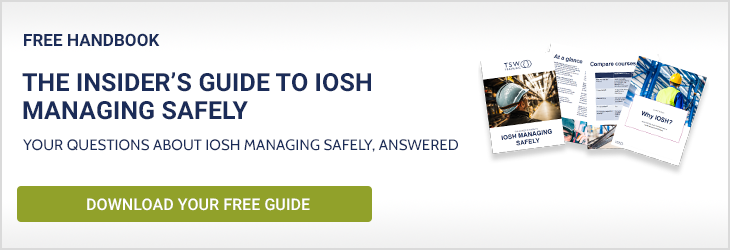Workplace health and safety policies comply with UK law and exist to keep everyone in your company out of harm’s way.
If you have responsibility for health and safety at work, or manage risks, part of your task is striking a balance between legal, moral, and fiscal needs.
Key points
- Health and safety isn’t just about complying with the law, you have moral and fiscal responsibilities too
- If workplace health and safety didn’t exist, injuries, work-related ill health and deaths would unfortunately be much more common
- You must have a health and safety policy if you have five employees or more
What does health and safety in the workplace mean?
We all have a part to play when it comes to health and safety.
This has been the case since 1974, when the Health and Safety at Work Act was introduced to UK workplaces.
It’s there to make sure everyone is protected and the workplace can run as usual.
Businesses have an even mixture of legal, moral, and fiscal considerations when it comes to health and safety. That balance allows them to run more productively, earn money, and as a result of compliance and good management, keep the staff safe.
Why is health and safety important when you’re at work?
Health and safety policies and procedures protect your team’s wellbeing in the workplace and safeguard your company’s future.
- Injuries, work-related ill health, and deaths would be more frequent if workplace health and safety didn’t exist.
- It would increase costs for employers scrambling to cover absence, legal costs and fines.
- If an employer hasn’t assessed the working environment or considered UK health and safety laws, it’s not possible to work safely.
- It’s also important to protect employees in the workplace, who need to be fit and healthy to continue working, and fund their way of life.
Keeping safe at work means we can do it all again tomorrow.
Who should be responsible for workplace health and safety?
Employers are always responsible, but health and safety managers, or those with responsibility, must regularly update their health and safety training to keep their skills relevant to the requirements of UK law.
The official answer from the Health and Safety Executive (HSE) is:
“It is an employer’s duty to protect the health, safety and welfare of their employees and other people who might be affected by their business. Employers must do whatever is reasonably practicable to achieve this.”
This gives you the impression that employers are the only ones with duties.
But the truth is we all have a responsibility for health and safety. We need each other to create an environment that benefits both parties, not just one.
Mutual effort creates a health and safety culture that shares values and beliefs. It is here where the responsibility truly lies; get this bit right, and most health and safety falls into place.
What are the main health and safety regulations?
The main set of regulations in health and safety are the Management of Health and Safety at Work Regulations 1999.
These regulations sit just above the other regulations because they are designed to provide more detailed information on what an employer needs to do to manage health and safety.
This is where you will also hear people talk about risk assessments, as regulation 3 of the management regulations discusses the need for employers to undertake suitable and sufficient assessments of risk so you can identify what risks employees will be exposed to while they’re working.
Other notable regulations are the Workplace Regulations 1992 which cover a wide range of basic health, safety and welfare issues like:
- Lighting
- Ventilation
- Workstations
- Traffic routes
- Toilets and washing facilities
Other relevant regulations are:
- The Quarries Regulations 1999
- The Health and Safety (Miscellaneous Amendments) Regulations 2002
- Work at Height Regulations 2005 (and CDM Regulations 2015)
Is it necessary for all businesses?
There are different regulations depending on your industry, but all businesses are covered by the Health and Safety at Work Act.
Construction for example, has its own best practices, qualifications and interpretations of the law.
The HSE recognise this by offering different industry approaches in their guidance and approved codes of practice.
You can buy HSE published books, like this guide to managing construction health and safety, or this guide to health and safety for warehouse and storage.
Health and safety laws you must know
The HSE health and safety law poster tells you the critical health and safety information:
What employers need to know
The document or poster informs employers that they need to decide what could harm an employee when doing their job and focuses on risk assessment.
It informs employers that they need to be able to communicate these risks to their employees in a way they will be able to understand and let them know who is responsible within the business to manage those risks.
What employees need to know
Employees are told to consult with their representatives of safety to protect themselves.
It states that:
- All training should be free of charge
- All equipment needed is also provided free of charge
- Welfare is provided
- First aid facilities are provided
- All major injuries are reported
- Insurance is displayed
- The health and safety of all other employers and contractors is protected
Common sense plays a huge part in health and safety, so although these points aren’t listed on the poster, they’re still critical:
- Employees should follow the training they have been given and use equipment as intended
- Take reasonable care of yourself and everyone around you
- Co-operate with your employer
- If you think something is wrong or dangerous, inform your employer
If you need further information, go to the HSE website and, if after speaking to your employer you are still worried, let the HSE know via their website.
What are the dangers of not complying to best practice?
The ultimate risk is that your employees could be put in danger, and injure themselves or others around them.
But there are also penalties for not complying that could see you paying up to £20,000, or even being sent to prison, not to mention the reputational damage your business could suffer as a result.
Health and safety is something you must take seriously if you’re responsible for other people’s wellbeing.
How to improve your health and safety standards
Use the ‘Plan, Do, Check and Act‘ or HSG65 model to help your business focus on your objectives.
NEBOSH will state that as long as you spend enough time on the check element, you will always succeed in health and safety.
Staying compliant is actually really easy; the HSE only change the law twice a year (6th April and the 1st October) and you can subscribe to their newsletters and updates, but this is just the legal element.
To get reassurance that what you’re doing is lawful and correct, there are two ways to check:
#1 Find a health and safety consultant or auditor
If you want a reliable consultant, go to the OSHCR webpage and find your local consultant.
This register should help you find the best advice from an industry-backed body supported by the Institution of Occupational Safety and Health (IOSH), International Institute of Risk and Safety Management (IIRSM), Chartered Institute of Environmental Health (CIEH), British Safety Council and NEBOSH amongst others so you can’t get any better support.
This person or company will audit you against what you have agreed in your policies.
They’ll report back to you with the results and some guidance on how to bridge any gaps or at the very least, inform you that everything you are doing is as it should be.
They may also provide you with a way to get to the next level.
#2 ISOs
You can also go for the standards route which includes ISO’s.
ISO state that their standards:
- Are internationally agreed by experts
- A formula that describes the best way of doing something
- Cover a huge range of activities, like making products, managing a process, delivering a service or supplying materials.
The ISO health and safety standard is 45001.
#3 Safety Schemes in Procurement (SSIP)
This is an umbrella scheme that covers many other schemes like CHAS, SMAS, Achillis and BSI and mainly looks at compliance with the law.
SSIP is ideal for smaller companies where ISO is not practical and like ISO, provides an external audit every year to prove your company is compliant.
#4 Invest in training and expertise
There are many different awarding bodies such as IOSH, NEBOSH, Highfields and NVQ and at TSW, we deal with all of the major players.
You could use IOSH Managing Safely for all your workforce and supervisors and then the NEBOSH General Certificate course for all managers and health and safety officers.
Once you pass the Level 3 in health and safety, you are at manager level and this will be your sole role.
Qualifications then extend to degree level – for example, The British Safety Council, NEBOSH and NVQ.
The consequences of not having a health and safety qualified person within the business is that you’re not compliant with the law.
How to monitor health and safety in the workplace
It’s crucial to keep reviewing your health and safety processes to make sure they still work for your business.
Regular inspections of your workplace as well as the equipment your team are using can help to keep everything in check, and there should be clear procedures in place for reporting accidents and injuries.
Make sure every new employee you bring on board is aware of health and safety processes, and the rest of the team is up to date with their training.
That way, you can be sure you’re complying with legal regulations, as well as keeping your team safe and well.









